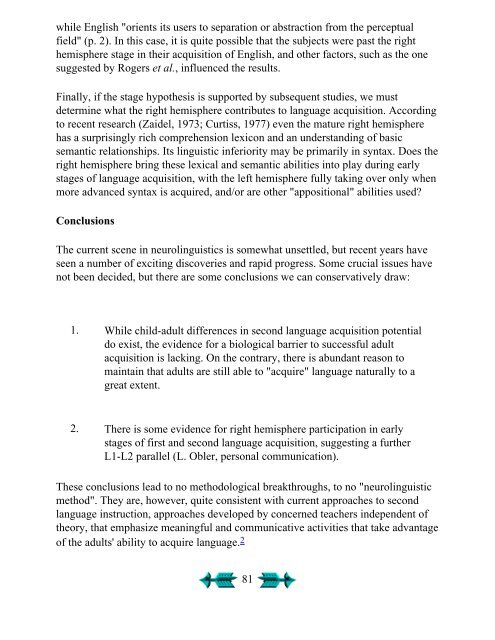Second Language Acquisition and Second ... - Stephen Krashen
Second Language Acquisition and Second ... - Stephen Krashen
Second Language Acquisition and Second ... - Stephen Krashen
You also want an ePaper? Increase the reach of your titles
YUMPU automatically turns print PDFs into web optimized ePapers that Google loves.
while English "orients its users to separation or abstraction from the perceptual<br />
field" (p. 2). In this case, it is quite possible that the subjects were past the right<br />
hemisphere stage in their acquisition of English, <strong>and</strong> other factors, such as the one<br />
suggested by Rogers et al., influenced the results.<br />
Finally, if the stage hypothesis is supported by subsequent studies, we must<br />
determine what the right hemisphere contributes to language acquisition. According<br />
to recent research (Zaidel, 1973; Curtiss, 1977) even the mature right hemisphere<br />
has a surprisingly rich comprehension lexicon <strong>and</strong> an underst<strong>and</strong>ing of basic<br />
semantic relationships. Its linguistic inferiority may be primarily in syntax. Does the<br />
right hemisphere bring these lexical <strong>and</strong> semantic abilities into play during early<br />
stages of language acquisition, with the left hemisphere fully taking over only when<br />
more advanced syntax is acquired, <strong>and</strong>/or are other "appositional" abilities used?<br />
Conclusions<br />
The current scene in neurolinguistics is somewhat unsettled, but recent years have<br />
seen a number of exciting discoveries <strong>and</strong> rapid progress. Some crucial issues have<br />
not been decided, but there are some conclusions we can conservatively draw:<br />
1. While child-adult differences in second language acquisition potential<br />
do exist, the evidence for a biological barrier to successful adult<br />
acquisition is lacking. On the contrary, there is abundant reason to<br />
maintain that adults are still able to "acquire" language naturally to a<br />
great extent.<br />
2. There is some evidence for right hemisphere participation in early<br />
stages of first <strong>and</strong> second language acquisition, suggesting a further<br />
L1-L2 parallel (L. Obler, personal communication).<br />
These conclusions lead to no methodological breakthroughs, to no "neurolinguistic<br />
method". They are, however, quite consistent with current approaches to second<br />
language instruction, approaches developed by concerned teachers independent of<br />
theory, that emphasize meaningful <strong>and</strong> communicative activities that take advantage<br />
of the adults' ability to acquire language. 2<br />
81











